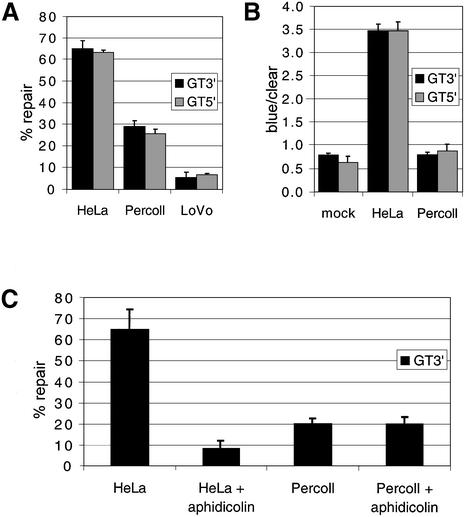Figure 1.
Repair activity in mitochondrial lysate. Nicked heteroduplex template carrying a single mismatch (either GT5′ or GT3′) was prepared and MMR assays performed with HeLa whole cell and percoll-purified rat liver mitochondrial lysate (‘Percoll’) as detailed in Materials and Methods. Following transfection, resultant plaques were scored as mixed or pure burst and the repair efficiency calculated. P-values for the statistical comparisons are shown. (A) Mitochondrial lysate repairs GT heteroduplexes. Repair activity is compared between MMR-proficient (HeLa) and -deficient (LoVo) cytoplasmic lysates and rat mitochondrial lysate (Percoll). For the GT3′: HeLa replicates, n = 6, total plaques counted, t = 2740; Percoll, n = 6, t = 2873; LoVo, n = 3, t = 1599. For the GT5′: HeLa, n = 6, t = 2751; Percoll, n = 6, t = 837; LoVo, n = 3, t = 570. (B) Mitochondrial lysate shows no strand bias for repair. The ratio of blue to clear pure burst plaques indicates strand bias, as is demonstrated by the HeLa lysate. The mock that represents the untreated heteroduplex shows no significant difference when subjected to repair by the mitochondrial lysate. Data is derived from the same experiments as (A). (C) Aphidicolin does not impair repair activity in mitochondrial lysate. Aphidicolin (120 µM), an inhibitor of nuclear polymerases α, δ and ε, was added to various lysates and repair of the GT3′ heteroduplex was measured. Data is from three separate experiments. HeLa ± aphidicolin, P = 0.005; Percoll ± aphidicolin, P =0.975.

